Eating & Drinking
Rice and fish are the staple diet for most Cambodians. Local specialities include curries, a variety of soups, and traditional beef, pork and poultry dishes. The national dish is amok, which is fresh fish steamed with coconut, curry paste and lemongrass in a banana leaf. Fresh seafood is also available and is especially popular with visitors travelling to the coast. Chinese and Vietnamese cuisine are also common in Cambodia, as is a variety of western cuisine which can be found in abundance in Phnom Penh and Siem Reap.
Water is generally untreated and not safe to drink. Bottled water, fruit drinks, soft drinks, coffee and tea are all widely available and are safe to drink.
1 . Pork and rice
Served early mornings on street corners all over Cambodia, bai sach chrouk, or pork and rice, is one of the simplest and most delicious dishes the country has to offer. Thinly sliced pork is slow grilled over warm coals to bring out its natural sweetness. Sometimes the pork will be marinated in coconut milk or garlic — no two bai sach chrouks are ever exactly the same. The grilled pork is served over a hearty portion of broken rice, with a helping of freshly pickled cucumbers and daikon radish with plenty of ginger. On the side, you’ll often be given a bowl of chicken broth topped with scallions and fried onions.

2. Amok
Fish amok is a fish mousse with fresh coconut milk and kroeung, a type of Khmer curry paste made from lemongrass, turmeric root, garlic, shallots, galangal and fingerroot, or Chinese ginger. At upscale restaurants fish amok is steamed in a banana leaf, while more local places serve a boiled version that is more like a soupy fish curry than a mousse.

3. Khmer red curry
The dish features beef, chicken or fish, eggplant, green beans, potatoes, fresh coconut milk, lemongrass and kroeung. This delicious dish is usually served at special occasions in Cambodia such as weddings, family gatherings and religious holidays like Pchum Ben, or Ancestor’s Day, where Cambodians make the dish to share with monks in honor of the departed.
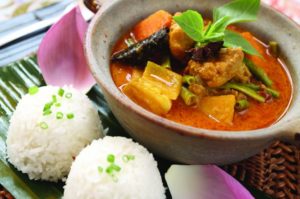
4. Khmer noodles
Nom banh chok is a beloved Cambodian dish, so much so that in English it’s called simply “Khmer noodles.” Nom banh chok is a typical breakfast food, and you’ll find it sold in the mornings by women carrying it on baskets hanging from a pole balanced on their shoulders. The dish consists of noodles laboriously pounded out of rice, topped with a fish-based green curry gravy made from lemongrass, turmeric root and kaffir lime. Fresh mint leaves, bean sprouts, green beans, banana flower, cucumbers and other greens are heaped on top. There is also a red curry version that’s usually reserved for ceremonial occasions and wedding festivities.

5. Bread
A remnant of Cambodia’s French-colonial past, fresh, crunchy breads are sold from street stalls and at markets – and make a great, low-cost breakfast or snack.

6. Tropical Fruit
Jackfruit, mangoes, bananas, pineapple, dragon fruit and watermelon are all plentiful in Cambodian. Get a street vendor to mix up a fresh juice or smoothie for a refreshing treat.
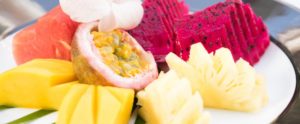
Language
Cambodia’s official religion is Theravada Buddhism. It was introduced in Cambodia in the 12th century. It is enhanced by traditional animist beliefs and Brahmanist practices long imported from India to form a very Cambodian fusion religion. There are also 500,000 muslims, mostly of Cham origin.
Shopping
Markets are plentiful in Cambodia – from the large markets like the Central and Russian Markets in Phnom Penh, to the smaller, local markets in regional areas. As with most markets in Asia, bargaining for a good price is commonplace. It’s also a good idea to check with your local customs officials to ensure that you are able to bring certain items back into your home country. Australia and New Zealand generally have strict quarantine laws.
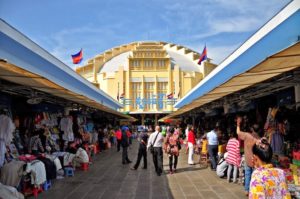
Things to by in Cambodia
1. Silver Jewelry
2. Stone and Wood Carvings
3. Traditional Cambodian Scarves (known as ‘Kramas’)
4. Hand-Woven Baskets
5. Silk Clothing and Sarongs
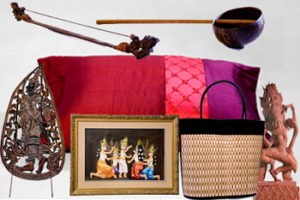
Festivals & Events in Cambodia
1. Khmer New Year
An important celebration in the Khmer calendar, the Cambodian New Year sees three days of people taking part in rituals, playing traditional games, performing gestures of goodwill towards others and enjoying feasts. Most Cambodians return to their homes to spend time with their families during this time but it’s still a fabulous time to see Cambodia shine.
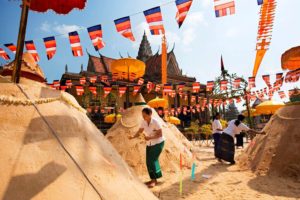
2. Pchum Ben Day
Ancestors’ Day” involves Cambodians visiting pagodas bearing food, flowers, rice and gifts, which are given to monks to offer to the afterlife so the dead do not haunt the living. This is a particularly poignant celebration given Cambodia’s recent history.
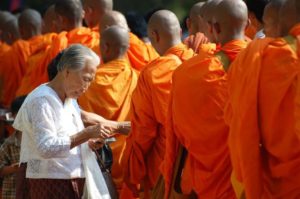
3. Water Festival
Celebrating the end of monsoon and the natural flow reversal of Tonle Sap and the Mekong, this festival is a visual feast featuring illuminated ornamental boats, music performances, colourful racing boats, fire works, dance, food and drink. With millions teeming into Phnom Penh, this is a great time to see Cambodia in high spirits – although it can get very crowded.






